Peruvian Maca Root Powder vs. Chinese Maca
If you’ve done a little bit of research you probably already know that Maca root originates in the high Andes mountains and is today primarily grown in Peru and Bolivia. What you probably don’t know is that over the past several years, China has also started growing and exporting Maca root products. This article explains the difference between the two and why you should insist on Peruvian Maca.
Maca From China?
We’ve been selling Maca since 2004 and taking it since 1998 so we were surprised in the past couple of years to receive multiple emails from Chinese companies offering to sell us Maca. At first we thought that they were re-selling Peruvian Maca, but further research revealed that these companies were selling Chinese grown Maca products. A quick search on one of the world’s leading import/export websites reveals over 3700 different companies listed that export Maca from China. See the graphic below:
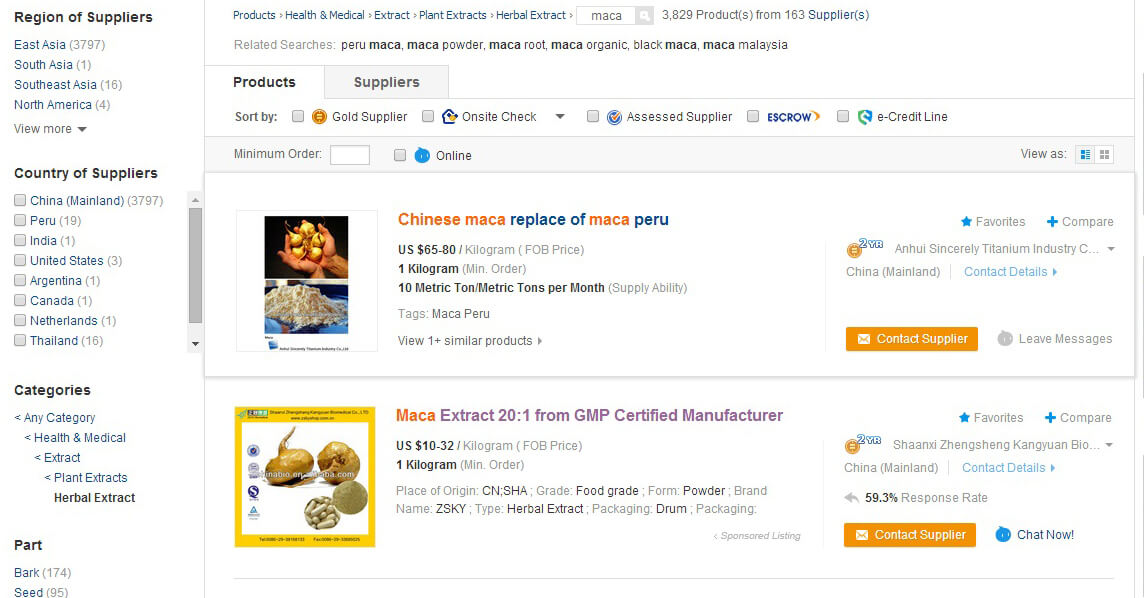
We were suspicious of these offers right from the beginning since our understanding was that Maca only grows in the very high elevations of the Andes. All of the research we had seen showed that while Maca plants can be grown at lower elevations these plants fail to produce roots of any significant size. Little did we know that the mountains in the Yunan province of China reach elevations above the 14,000 feet ( M) at which Maca plants do produce roots. Indeed, Chinese farmers have imported seeds from Peru and are growing Maca roots. But there are some major issues with these products.
The Five Major Issues With Chinese Maca
First, we’ve discovered in China that laboratories are actually producing a synthetic form of Maca and trying to pass it off as authentic Maca root. This would be like creating a wheat flour substitute in the lab and then selling it as the real deal. Needless to say you want to avoid anything synthetic when it comes to your food.
Second, China grows and exports a relatively large number of superfoods including rice protein, grass powders, hemp seeds, goji berries and more, so it’s not surprising that they have chosen to cultivate Maca as well. The unfortunate reality is that these foods carry a high risk of contamination. China is one of the most heavily polluted countries in the world. Check these statistics from a very important article on Natural News (after we read this article, we checked where all of our personal superfoods come from - we hope that you do too!)
- China’s own Ministry of The Environment admits that 19.4% of its arable land has been heavily contaminated by toxic heavy metals
- 82.8% of non-organic produce in China exceeds the government’s own heavy metal limits
- 60% of China’s groundwater is now too polluted to drink
- Cadmium and Lead have been found in Chinese superfoods purchased at Whole Foods
- BBC reports that at least 1/5 of all arable land in China is contaminated
Based on this information, anyone who cares about health should avoid eating any food produced in China. Still, knowing that Maca grows at higher elevations, someone might argue that this type of contamination might not affect Maca production. While that could be true, it’s important to keep in mind three facts about the Yunnan province where Maca is grown:
- Yunnan province has a long history of Chromium pollution and according to at least one article serves as a “chromium dump”
- 70% of water in Yunnan province fails to meet water quality standards
- Yunnan has been exempted from the requirement to curb pollution.
Third, you can see the quality of the roots grown in China vs. Peruvian Maca roots from our farm for yourself in the images below. Notice how symmetrical and beautiful the Peruvian grown roots are compared to the Chinese ones.
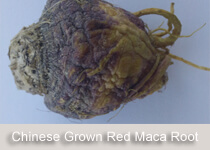
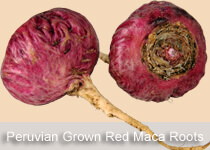
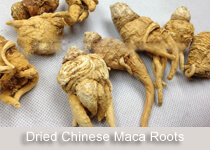
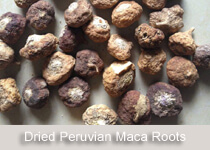
Fourth, we've recently learned from a powerful documentary (you can see it here), that the Chinese already hold 7 GMO patents on Maca. That means that there is no way to tell if Maca from China is GMO free or not. Remember, Peru has banned GMOs at least until 2021.
Finally, Maca originated in the high Andes of Peru and is a national heritage food of Peru. Since 2003 it has been illegal to transport whole roots or seeds outside of Peru. And yet, Maca is currently grown in China. According to the documentary report listed above, Maca cultivated in China certainly came from seeds smuggled out of Peru. What is more, China apparently does not acknowledge this nor does it have any contract with Peru to grow Maca. To buy Chinese grown Maca is to support this type of practice in our opinon.
How To Know Where Your Maca Comes From
All quality sellers of Maca should list where their Maca comes from right on the label. If they don’t it may be that they are using inferior quality Chinese Maca. Please find out for sure before you purchase.
At The Maca Team we only source and sell Maca from a small co-operative farm in the highlands of Peru. All of our products are certified to be free of any sort of contamination before they are shipped. You can rest assured that we will NEVER compromise on quality and will continue to ALWAYS exclusively sell Maca from Peru.
Update From Someone Who Lives In Yunnan China
After we learned that Chinese citizens are smuggling tons of Maca out of Peru this year, we reached out to William Irion, who is one of our customers and affiliates. Here's what he's told us about the Chinese Maca situation:
“The overall maca crop in Yunnan is going to be huge this year. The market is and will be flooded with Yunnan grown low to no quality maca, fake maca, synthetic maca and some really decent product. The good product, that has been tested, is from Lijiang area of northern Yunnan province China grown under the supervision of the Yunnan Academy of Agricultural Sciences. Its grown at the same altitudes and general climate as in Peru. Wither all the benefits of real Peru maca are actually in this Yunnan gown maca remains to be seen. I am told some tests indicate it is close. Having another source of good full benefit Maca in the world is not a bad thing but it remains to be seen.
On maca roots in China, many Chinese prefer to buy the actual root to eat or process themselves. They believe or think, in many, cases its the “Real” thing if its the root they can see. The roots could have pesticides or heavy metals or even be soaked in some chemical to preserve their appearance. They often put or soak roots in 150 proof grain alcohol which does destroy some beneficial properties. It’s a traditional Chinese medicine way. Many of the Chinese know how their companies process products and how they are adulterated by many these same Chinese so called companies. The Chinese government is doing more and more to stop this. There are new food safety laws in place this year. Imported bulk maca power or so called “maca” power has been seized and destroyed by the Chinese government this year.
On the Peru Maca root situation, some Chinese nefarious organizations started world sourcing Peru maca root in the middle of this year. I was asked to do this and declined. Its Illegal! The roots sourced in Peru were most likely smuggled out to neighboring countries of they could be Bolivian maca root too. I suspect the roots will be smuggled into China by these same nefarious organizations in large cargo containers. Who knows what condition the maca root will be in when it actually arrives in China, if it gets in and what they might do it to keep looking good.”
Not surprisingly we've recently been approached by growers of Chinese Maca - we're getting several contacts a week. We will never purchase it, but we now know that at least part of the strategy on the part of Chinese companies is to compete with Peru in the worlwide Maca market. Here's and example of one of the contacts we are receiving:
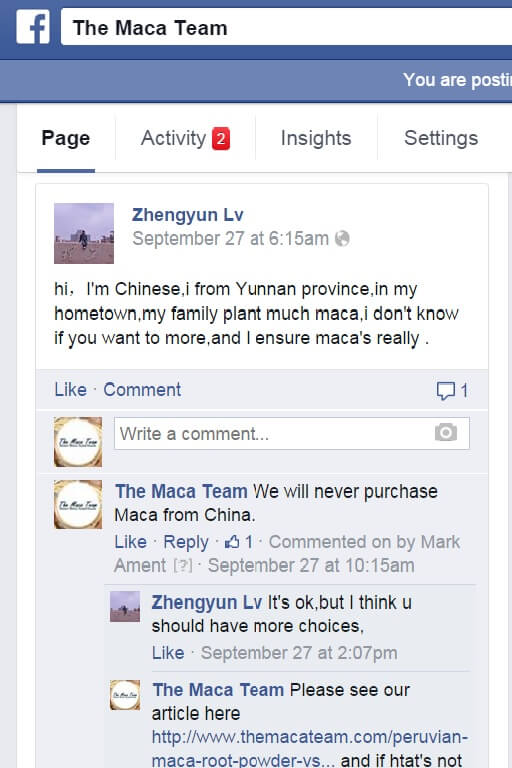
Here are some recent comments from a customer of ours from Hong Kong. He emphasizes the importance of using high quality Peruvian grown Maca.
"I have tried several different sources of maca powder and this one is by far superior! I am currently living in Shanghai on business and have access to several types of maca offered out here. I've watched them pulverize it for me from actual root in Hong Kong and I've had friends import some for me from Malaysia. All far short in comparison to the quality offered by The Maca Team. I pay a little extra to have it shipped out this far and don't even flinch because it's worth it. Some of my friends out here from Hong Kong ask me to order for them as well now that they've tried it and love it, (not to mention the group pricing on shipping is always nice). I lift weights and live a fit and active life but also work long hours most days. I'm in my early thirties, in very good shape, eat healthy and don't believe I need any additional help. Having said that, this maca has helped me fill in the spaces of my nutrition and I feel more solid with it than without. I don't need to repeat all the benefits of what the company already states, but I would like to confirm them. I feel as though it helps my body run like the machine it should be. I'm starting to order some for everyone I care about as gifts. They'll thank me later. Thanks so much for what you do and I look forward to our long relationship together!" - Andrew
We hope you’ve enjoyed this article and encourage you to share this information with all your friends and family who eat superfoods.
Let us know if there is anything we can do to help.
Enjoy you day!
![]()
